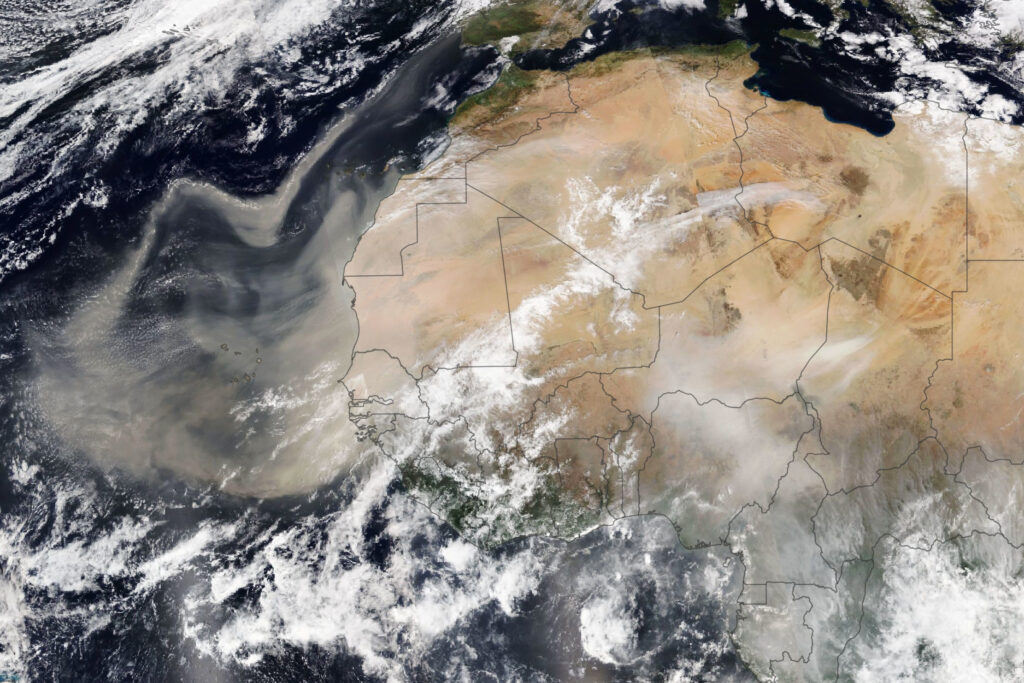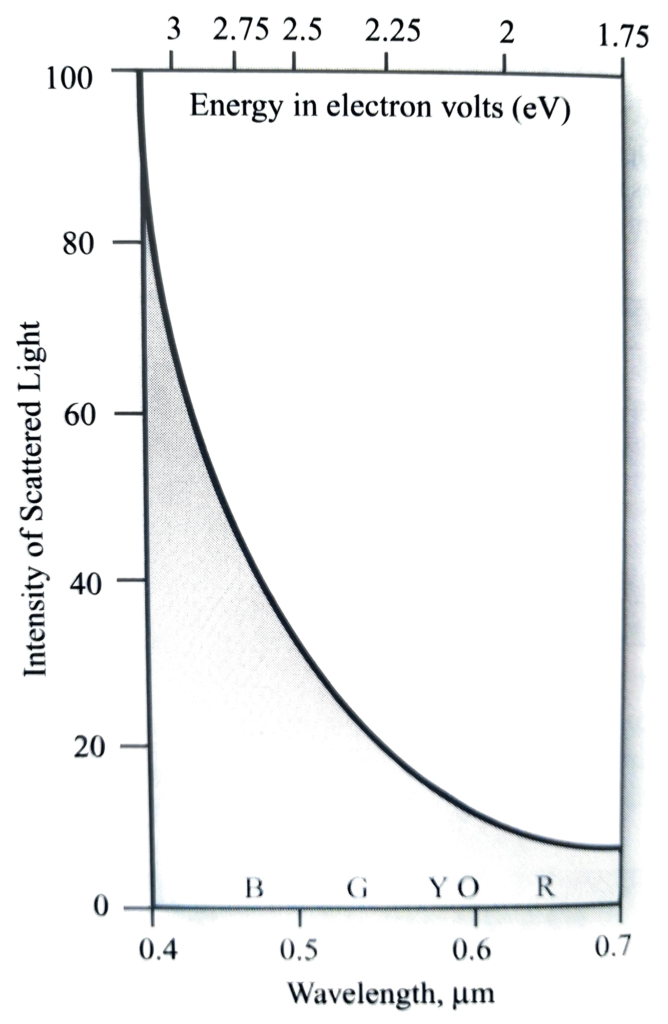On the way to the Earth’s surface – Atmospheric Interaction

Learning objectives of this topic
- Atmosphere in Remote Sensing context
- Scattering mechanisms in the atmosphere
(linked with natural phenomena) - Absorption in the atmosphere
In this topic, you will learn about the interactions that take place between the different forms of radiation you learned in previous chapters with the Earth’s atmosphere. The layer surrounding our planet has tremendous effect on the signal that we are measuring. While some wavelengths are more or less immune to this kind of influence (you will learn about this later), others produce uninterpretable signals. The atmosphere is not a vacuum and, therefore, the radiation gets altered in different ways.
A protective layer – the atmosphere
Before solar radiation reaches the Earth’s surface (this distance is referred to as ‘path length’), the atmosphere will influence it in different ways. Hence, the strength of different types of electromagnetic (EM) radiation is severely transformed through the course of the atmosphere as it consists of molecular nitrogen, oxygen, water vapor and particles (aerosols) such as dust, smoke or industrial pollution. The impact of such particles can be massive. In February 2021, great amounts of sand from the Sahara desert were relocated to Europe due to seasonal winds, heavily affecting the signal that passive sensors measure (lower right).
The changes in the radiation can vary with wavelength, condition of the atmosphere, and the position of the sun. So, how does the atmosphere interact with the radiation? Generally, the atmosphere has its strongest impact on the shortest wavelengths used in remote sensing, such as the visible and the infrared spectrum.
Different mechanisms affect the radiation. Absorption is caused, for example, by the presence of water vapor in the Earth’s protective layer. Of course, when arguing from a remote sensing perspective, the atmosphere can also be seen as a hindering factor regarding image interpretation and retrievals of e.g. “true” surface reflectance. Scattering and absorption in the atmosphere cause a transmission loss of the solar radiation before it reaches the Earth’s surface. In parts of the EM spectrum, the atmosphere is hardly or not at all transparent, thus these parts are not suitable for certain wavelengths used in RS. Those parts of the spectrum where the atmospheric transmittance is high (depending on the wavelength of interest), which are specifically useful for RS applications, are called ‘atmospheric windows’. Common atmospheric windows are visualized below.
Scattering in the atmosphere
Through the route that the radiation takes to pass the Earth’s atmosphere, a variation of physical processes takes place that alter the EM waves. Processes of scattering and (partial) absorption define the appearance of the Earth and its surrounding layer and their modelling is complex, while they are the most relevant ones to remote sensing applications. Essentially, there are three types of scattering: 1) Rayleigh, 2) Mie and 3) nonselective.
Why is the sky blue?
The color of the sky as we see it is usually a shade of blue. This can be attributed to the location of blue light in the visible part of the EM spectrum (approximately 0.4 – 0.7 µm or 400 – 700 nm). Due to its very short wavelength, it is most likely to be scattered from the smallest particles in the atmosphere. This is also displayed in the figure on the right side. In particular, in the upper layer of the atmosphere, this process called ‘Rayleigh scattering‘ (or ‘molecular scattering’) is common. While longer wavelengths simply pass through the particles, shorter wavelengths exhibit a greater probability of being scattered. The molecules involved in the scattering process are usually the size of 1/10 of a wavelength.
The plot on the right displays why blue is so dominant. The intensity of scattered light is greatest in the blue part of visible spectrum. You can see that the amount of Rayleigh scattering varies inversely with the fourth power of the wavelength. This scattering mechanism is strongest between 2 and 8 km above the Earth’s surface, where the proportion of gas molecules is the largest.

When sunrises are redder than usual.
When the particle size/diameter (d) is approximately equal to the wavelength (λ) another process comes into play. You can see this behavior illustrated in the figure on the right. This process, called Mie scattering, is interacting stronger with longer wavelengths, when compared to Rayleigh scattering. In areas where the air pollution is greater or the amount of smoke and dust particles is higher, more of the violet and blue portions of the EM spectrum will be scattered away and the reddish tones directed to the eye.
The size of particles, which lead to Mie scattering, such as dust or smoke particles, vary in size between 0.1 to 10 times the wavelength of the given EM wave.

Why do clouds appear white?
Moving even further down the atmosphere, where particles diameters exceed λ of the incident radiation by factors > 10, nonselective scattering is the third important process happening in the atmosphere. It occurs when the particles are significantly larger than the wavelength. Consequently, water droplets and ice crystals lead to similar scattering in all visible wavelengths, resulting in the white appearance of clouds.

Absorption in the atmosphere
Understanding where our atmosphere absorbs which parts of the EM radiation is crucial to be able to understand the signal a remote sensing instrument is receiving. A main difference between atmospheric absorption and scattering is the effective loss in energy to atmospheric constituents. The energy is directly transferred into objects, or the remote sensing targets. Molecules like ozone, carbon dioxide or water vapor can warm our planet by absorbing energy.
From a remote sensing point of view, the main objective is to use wavelengths that tend to avoid areas in which the absorption is great. Wherever the atmosphere exhibits a high transmissivity for an incoming wavelength, we talk about ‘atmospheric windows‘.
The big atmospheric windows between 1 mm and 1 m allow us to operate microwave systems, which we know as radar sensors. Atmospheric windows in the multispectral portions of the EM spectrum are narrower in comparison.
Keeping this in mind, a lot of caution should be taken when selecting RS instruments and three important questions should be considered carefully:
1.) What is the spectral sensitivity of my sensor?
2.) Which atmospheric windows can be used with this sensor?
3.) What is the source, magnitude and composition of the outgoing signal we are aiming to analyze?
Sources & further reading
Elachi, C. & van Zyl, J. (2015²). Introduction to the Physics and Techniques of Remote Sensing. Hoboken, USA: John Wiley & Sons, Inc.
European Southern Observatory (ESO, 2010). Transparency of the atmosphere. <https://www.eso.org/public/germany/images/atm_opacity/>
Jensen, J.R. (2007²). Remote Sensing of the Environment. An Earth Resource Perspective. Upper Saddle River, USA: Pearson Prentice Hall.
National Aeronautics and Space Administration (NASA) Earth Observatory (EO, 2021). Saharan Dust Heading For Europe. <https://earthobservatory.nasa.gov/images/147952/saharan-dust-heading-for-europe>
Rees, W.G. (2010²). Physical Principles of Remote Sensing. Cambridge, USA: Cambridge University Press.
Schowengerdt, R.A. (2007³). Remote Sensing. Models and Methods for Image Processing. San Diego, USA: Academic Press.





